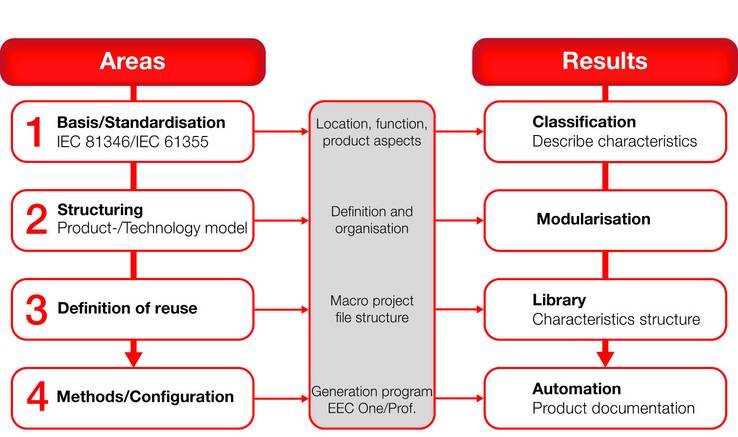Standardisation: Step by step to improved efficiency
EPLAN has developed a 4-step plan for the successful implementation of “Standardised Engineering”. The result: Reduced complexity, increased reuse and maximum product flexibility.
How can process costs be reduced to enable a quick, flexible reaction to customer requirements? EPLAN has developed a 4-step plan for the successful implementation of “Standardised Engineering”. The result: Reduced complexity, increased reuse and maximum product flexibility. Companies can benefit from lower process costs and increased effiency in engineering. Monheim, 08 April 2013. For the standardisation in engineering, both the product and the process sides need to be taken into consideration. On the product side there are the platform strategies, which allow a large number of product variants to be generated from a range of similar components. On the process side, organisational and work standards can be developed to simplify complex workflows and even increase flexibility by means of clever combinations. Therefore, it is important to standardise individual steps in the engineering process even the applications are different. Level 1: Standardisation
Studies show that many companies have already tried to implement standardisation, but have failed due to the demands and time requirements of day to day business. A project analysis also needs to be carried out before a solution can be applied to the software. The most important element of this process is change management, which involves all those affected by change, adopting a new way of thinking. Once the basic prerequisites are in place, the first stage of standardisation can begin. IEC 81346 forms the basis for the structuring of products, machines and plants - covering as many disciplines as possible and with consistent terminology. Only exact knowledge and clear definition of the individual products, including the correct terminology, understanding of assemblies, functions and variants can provide the basis for the following steps. Level 2: Product model/Technology model
Determing product structure from the view of the customer forms a product model which throws up the following questions: What are the product functions of the machine from the perspective of the customer? Clear structuring is required – all employees involved in the engineering process need to work together as all departments have their own view of the machine. For example, the mechanic sees modules and assembly units from a physical perspective. The electrical engineer thinks in higher-level logical structures and in manufacturing, it is all about productions characteristics such as installation and mounting locations. The product structure is enriched with more and more specific information along the entire development process, from the first idea to implementation. So it is all the more important that a clear product structure is established. It is therefore important to determine: “Which properties can be calculated automatically based on pre-defined properties?” The number of degrees of freedom or selection criteria are automatically set in rules and dependencies. This is the basis for subsequent automatic configuration. Interim summary: Complexity is minimised - at the same time, increasing the chances for clear manageability and definition of rules. The infrastructure is generated automatically - for example the current range for the main switch, the number of inputs and outputs (I/O) or the safety technology required. These values can be derived. As part of the structuring process, the main task is to record knowledge in values and rules which the project engineer can define on an intuitive basis. By contrast, the technical structure represents the technical configuration of the variant to be produced - for example construction, drawing, switches and program component. Level 3: "Definition of reuse"
You often hear people say that there is no room for reuse in mechanical engineering. If you start at the module level, this claim appears correct. If you go one or two functional levels deeper, the hypothesis is destroyed. Similar basic functions are often used, with each industry having its own focus functions. So the aim of this stage is to recognise the functions for reuse and describe them clearly as the basis for a reusable construction template. EPLAN Consultants can utilise their experience from various projects and best practices. Level 4: Method/Configuration
What engineering method is the most efficient? Each approach is based on one of these construction methods: copy engineering, maximum project or option engineering, and generation technologies. Depending on the results of Steps 1-3, the right decision for engineering and construction of the product structure required can be derived at this stage. The result is the most favourable process for the individual company. This method also determines the significant gain in efficiency within the company. EPLAN GmbH & Co. KG, April 2013
Download
- <link file:24583 download file>Press kit (zip)



